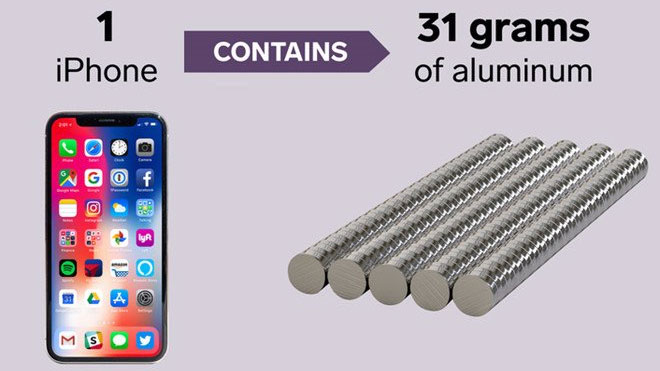How much metal and rare earth does Apple need to create an iPhone?
To create an iPhone, Apple needs to use aluminum, iron, gold and some rare earths.
The iPhone is made up of various metals including titanium, iron, gold and a large amount of aluminum used to make the case.
According to a study from Motherboard, aluminum accounted for about 24% of the iPhone's mass, followed by iron with about 14%. Copper accounts for 6% and cobalt accounts for 5% of the phone's weight.

The iPhone is made up of many metals such as aluminum, iron, gold and rare earths.
In addition, rare earths such as yttrium and europium are also important in forming the iPhone. They are used to build in the phone's battery, making the screen color display and making the phone vibrate when notified.
Although they only account for a very small part of the total volume of the phone, rare earths are very important.
However, the exploitation of these materials can cause a combination of radioactive materials and carcinogens. They will infiltrate water sources, destroy surrounding forests and farmland, seriously affecting the environment.
Miners are also severely affected by health, cancer prone and many other diseases.
According to Quartz, Apple said it used recycled materials to produce phones instead of rare earths to protect the environment and the health of workers.
- Apple registered the iPhone glove copyright
- Listening to an expert explaining that 'rare earth is not as rare as the name'
- 8 signs to distinguish genuine iPhone cable and fake
- Hackers 'group look' Apple iPhone
- Things you do not know about rare earth
- iPhone will not support CDMA
- Apple was sued for ... discounted iPhone
- Microsoft: 'iPhone is Apple's challenge'
- This day 10 years ago, iPhone was born
- Japan is allowed to exploit rare rare earths in the Pacific
- Apple, Cisco will continue negotiations on the iPhone brand
- Turn your iPhone into a smart indoor control device
 'Fine laughs' - Scary and painful torture in ancient times
'Fine laughs' - Scary and painful torture in ancient times The sequence of numbers 142857 of the Egyptian pyramids is known as the strangest number in the world - Why?
The sequence of numbers 142857 of the Egyptian pyramids is known as the strangest number in the world - Why? History of the iron
History of the iron What is alum?
What is alum?